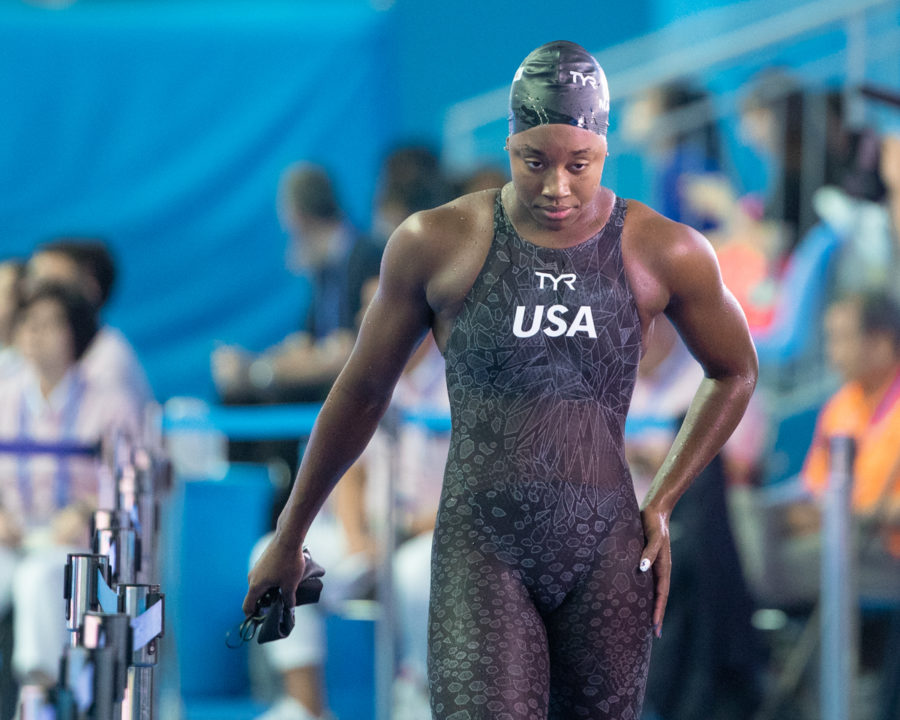2020 PRO SWIM SERIES – KNOXVILLE
- Thursday, January 16 – Sunday, January 19, 2020
- Knoxville, TN – Allan Jones Intercollegiate Aquatic Center – University of Tennessee
- Long course meters (LCM) format
- Thursday distance session: 4 PM (U.S. Eastern Time)
- Fri-Sun.: 9:30 AM Prelims / 6:30 PM Finals
- Meet site
- Live Stream
- Psych Sheets
- Live results
American sprinter Simone Manuel is headed toward the 2020 Tokyo Olympic Games as the favorite in the women’s 100 free: a status she has earned over swimmers like Cate Campbell and Sarah Sjostrom, both of whom have superior ‘lifetime bests,’ but both of whom have been beaten by Manuel at the last 2 World Championships and the 2016 Olympic Games.
Manuel’s 52.04 from last year’s World Championships puts her in the same territory as Campbell, who has a lifetime best of 52.03, and Sjostrom, who has a lifetime best of 51.71.
While Manuel will probably never expect to be as fast as Sjostrom or Campbell in season, her improved taper times since her Olympic gold (which was in a time of just 52.70) have been accompanied by better in season times as well.
That was true of her 100 free on Sunday, where Manuel qualified first for the final in 53.49 – ahead of a 53.94 from Erika Brown.
The results are significant for both swimmers. For Manuel, that time is much faster than she usually swims in preliminary rounds. Among non-championship meets, Manuel has only been faster three times: a 53.30 in Santa Clara in June of 2019 (that was a prelims swim, she scratched the final); a 53.42 in finals of last year’s Knoxville meet (there she was 54.15 in prelims); and a 53.44 in Greensboro in November (there she was 54.12 in prelims). That shows a pretty consistent in-season pattern for Manuel in 2019, and a pretty significant improvement upon that pattern in the first data point in 2020.
Prior to 2019, her best in-season swims were usually closer to 53.6 or 53.7.
It was easy to read into Manuel’s fast morning swim as an indicator of a scratch, but remember this: at the World Championships last year, she was very close to not even making the final. In the semi-finals, she tied as the last qualifier with Britain’s Freya Anderson. .13 seconds slower and she wouldn’t have been in the final at all. So this more aggressive prelims approach could be an effort to shore that up as well.
For Brown, the story is very different. Her 53.94 in prelims on Sunday is the second-fastest time of her career. It’s been a breakout season for Brown in long course – in November, at a long course session of her short course collegiate mid-season invite, she swam 54.15. That was very-nearly a best time. Then 2 weeks later she swam the two fastest times of her career, amounting to a 53.42 at the U.S. Open in finals that dropped .71 seconds.
Now she’s undercut her Summer Nationals taper-meet time again this season in long course. Unlike Manuel, Brown is still trying to climb the mountain: she wasn’t even on the U.S. team for the World Championships last summer. She’s now positioned herself for a minimum of a relay spot in Tokyo, and a battle with swimmers like Abbey Weitzeil and Mallory Comerford for an individual swim in this 100 free as well.
This 100 free follows a 24.57 in the 50 free earlier in the meet for Brown, which did set a new personal best for her (by .01 seconds).
These are more signs that the American women’s sprint group could actually challenge the World Record-holding Australians, who have a group that looked like it might be unbeatable for a generation. The Australians won’t give up that spot easily, though, with a sprint group in its prime, anchored by Cate Campbell, who in spite of her individual struggles remains the world’s most effective relay swimmer.
